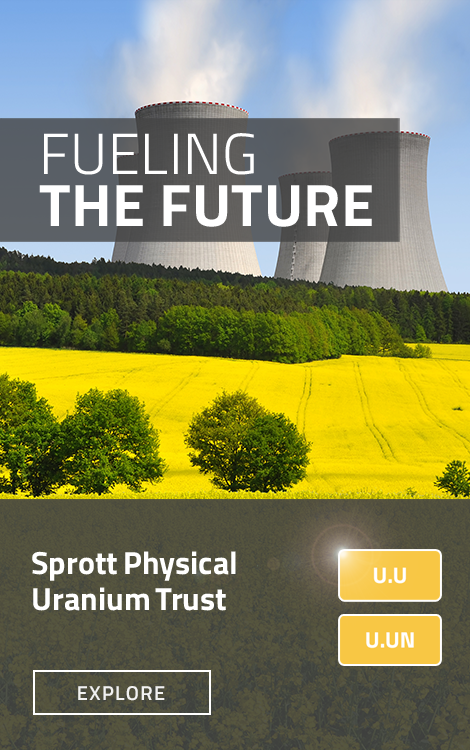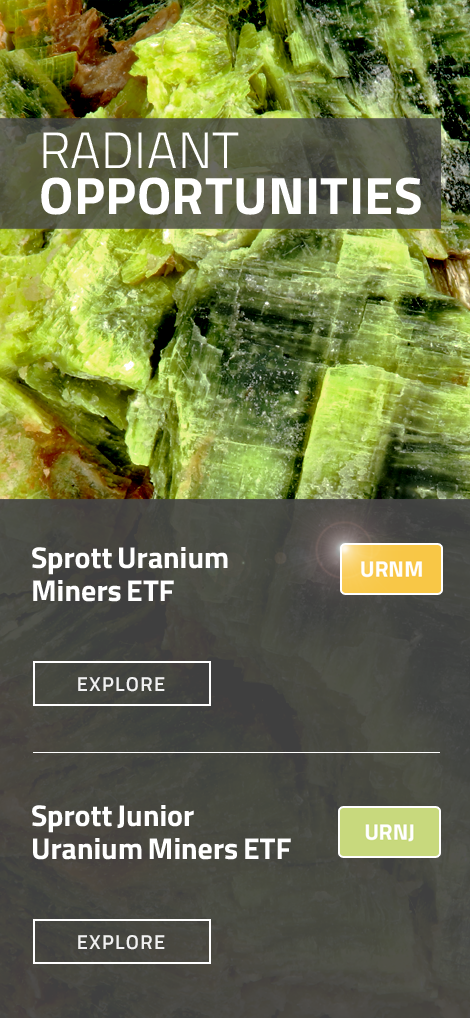As of yesterday's close (9/21/2023), spot uranium and uranium mining stocks have gained 38.86%1 and 37.91% year to date,2 respectively, outperforming the S&P 500 TR Index's YTD gain of 14.14%.3
Nuclear Power's Renaissance
The nuclear energy industry is experiencing a worldwide resurgence after years of underinvestment. Nuclear power offers an efficient, reliable, safe and environmentally friendly energy source that could be the answer for countries striving to achieve net-zero carbon emission targets and enhance energy security. As more nations adopt pro-nuclear stances, we believe that uranium and nuclear power will become essential in addressing the rising global electricity needs as energy consumption grows.
Global sentiment toward nuclear energy has improved significantly in the past few years, reigniting the industry after the “lost decade” that followed the 2011 Fukushima Daiichi power plant disaster. Currently, 434 nuclear power plants operate worldwide, with 59 under construction and 111 more planned (see Figure 1).4 Of these, China is constructing 23 new nuclear plants, augmenting its existing fleet of 55. The year 2023 has witnessed an unparalleled wave of announcements for nuclear power plant restarts, life extensions and new builds. Moreover, utilities are poised to ink contracts for uranium in volumes not seen since 2012.
Figure 1. Nuclear Reactors in the World Today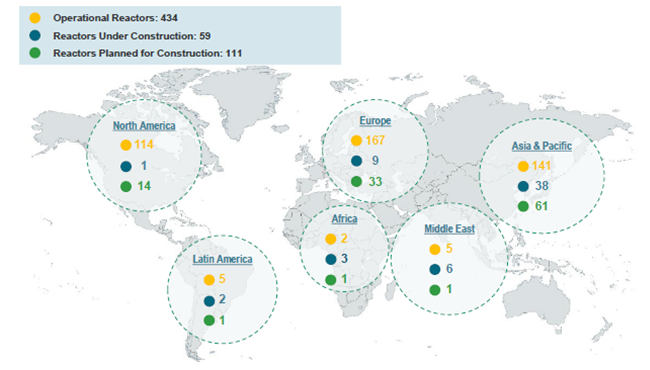
Source: World Nuclear Association as of 8/1/2023. Included for illustrative purposes only. Past performance is no guarantee of future results.
An Evolving Energy Landscape
Shifting demographics are driving an anticipated 76% surge in global electricity demand by 2050 relative to 2021 (see Figure 2).5 In developed regions, this demand is largely attributed to technological advancements, notably the rising adoption of electric vehicles and the expansion of consumer electronics. Conversely, in developing nations, factors such as rising incomes, population growth and a burgeoning middle class are catalyzing an increased demand for modern technologies.
Figure 2. Global Electricity Demand Estimated to Increase 76% by 2050
Source: IEA World Energy Outlook 2022 Stated Policies. Methodology for estimates is outlined in the International Atomic Energy Agency report “Analysis of Uranium Supply to 2050". Included for illustrative purposes only. Past performance is no guarantee of future results.
As societal and technological progress expands energy demands, the energy transition is steering us from traditional fossil fuels toward renewable energy sources. It's projected that by 2025, renewables will constitute 35% of global power generation, up from 29% in 2022.6 Though wind, solar and hydroelectric power often symbolize renewable energy, unpredictable weather events can compromise their reliability. More reliable energy sources like nuclear power are essential to ensure stable baseload power and keep economies functioning.
Why Nuclear Power?
Nuclear power plants have undergone significant advancements over the past few decades. Enhanced technology allows these plants to operate with greater efficiency and experience fewer, shorter disruptions in power delivery.
Compared to traditional and alternative energy sources, nuclear energy boasts the highest capacity factor,7 solidifying its position as the most reliable baseload power source. Moreover, the energy density of uranium surpasses other fuels, making it immensely potent.
In terms of environmental impact, nuclear energy emits the least CO2 equivalent compared to other energy mediums and has the smallest full-cycle carbon footprint. Furthermore, the waste it generates is minimal. To illustrate, the accumulated spent nuclear fuel from the U.S. over the past six decades could fit within the confines of a football field, stacked less than 10 yards high.8 (Learn more in “Key Facts about Spent Nuclear Fuel” by Per Jander.)
Notably, nuclear power stands out for its safety. Statistically, it's substantially safer than fossil fuels, as shown in Figure 3.
Figure 3. Nuclear Power Boasts Among the Lowest Mortality Rates
Per Terawatt Hour (TWh) of Energy Produced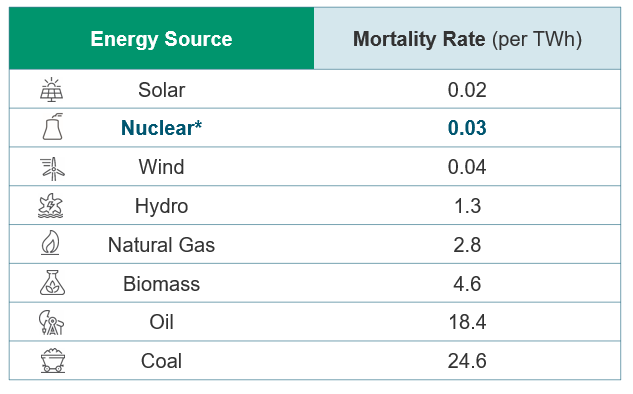
Source: Our World in Data, Nuclear Energy as of 2022. Represents the most up-to-date information available. *Death rate for nuclear energy includes deaths from Fukushima and Chernobyl disasters and deaths from occupational accidents (largely mining and milling). Death rates from fossil fuels and biomass are based on state-of-the-art plants with pollution controls in Europe and are based on older models of the impacts of air pollution on health. This means these death rates are likely to be very conservative. Included for illustrative purposes only. Past performance is no guarantee of future results.
Growing Positivity Toward Nuclear Power
As we mentioned, sentiment toward nuclear power has been growing more positive, especially following Russia’s invasion of Ukraine in early 2022. Fifty-seven percent of Americans say they favor more nuclear power plants to generate electricity, up from 43% in 2020, with both political parties showing increasing support.9
Historically, safety concerns have made investors and the public wary. However, the pressing need for clean energy is now overshadowing these apprehensions. We believe these fears have been disproportionately magnified and are rooted in Cold War-era "nuclear apocalypse" narratives. With the post-COVID scenario characterized by soaring gas and oil prices, consumers are actively seeking alternative energy options.
Influence of Global Policy
Governments worldwide are recognizing the indispensability of nuclear power in achieving their carbon-neutral and security objectives. North America and Europe aim to reduce their dependence on Russia for uranium, channeling significant financial resources toward clean energy initiatives. In the U.S., President Biden's heralded infrastructure bill, the Inflation Reduction Act (IRA), allocates over $10 billion to bolster at-risk nuclear power plants and advanced nuclear energy initiatives. In total, the IRA earmarks $369 billion for clean energy incentives. Canada has shared positive updates on nuclear energy this year, including advancements and budget allocations for several refurbishment projects.
Uranium miners may be poised to generate higher revenues and potential profits as uranium mining production ramps up.
Although France remains the leading figure in nuclear energy in Europe, "new nuclear" movements are gaining political traction in Sweden, Belgium, Finland and the Netherlands. The UK is also channeling funds toward nuclear power, primarily focusing on reactor life extensions and new infrastructure projects. China has set an ambitious target of achieving 400 gigawatts by 2060, intending to supply roughly 18% of its electricity demand. 10 In Asia, Japan has reactivated 10 nuclear power plants and has plans for an additional 15. Concurrently, South Korea is expanding its program by reversing its previous stance on phasing out nuclear energy.
Geopolitics and Energy Security Considerations
As the world moves toward renewables, energy security is becoming an increasingly important consideration. The ongoing Russia-Ukraine war has highlighted Western nations’ dependence on Russia for uranium fuel. In response, countries seek to secure their energy pipelines and decrease reliance on Russia and China. As shown in Figure 4, U.S. production of uranium oxide has fallen substantially since the 1990s and the U.S. relies heavily on imports from Russia and elsewhere. U.S. and European governments have proposed legislation to impose sanctions on nuclear fuel from Russia, and utilities are scrambling to find replacement uranium coverage. Roughly half of the total uranium production in 2022 came from Kazakhstan and is shipped through Russia (see Figure 5).
Europe is particularly susceptible to uranium supply disruptions. Its quest for energy security took another potential blow in August 2023 as the Niger coup put the Trans‐Saharan gas pipeline construction at risk and the new regime threatened to suspend uranium exports to France, a leading producer of nuclear energy. At this writing, no uranium is being exported from Niger.11
Figure 4. U.S. Uranium Oxide Production Has Declined Significantly (1949-2022)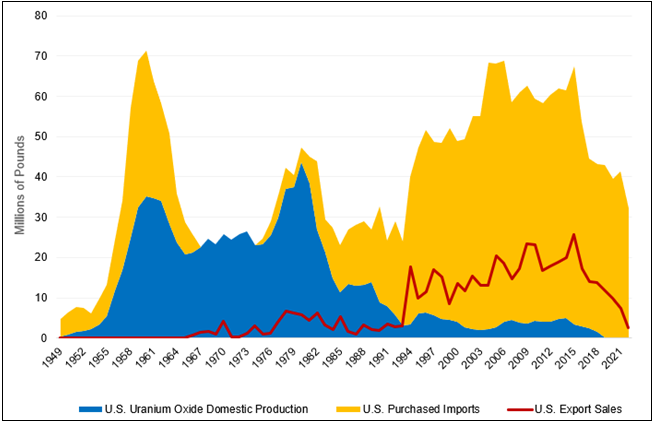
Source: U.S. Energy Information Administration, August 2023, Monthly Energy Review. Included for illustrative purposes only. Past performance is no guarantee of future results.
Figure 5. Russia Controls a Significant Amount of Uranium Supply 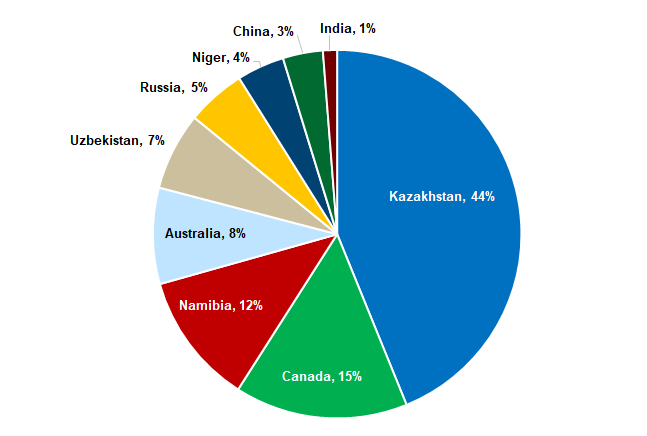
Source: World Nuclear Association as of 12/31/2022. Included for illustrative purposes only. Past performance is no guarantee of future results.
Challenging Supply-Demand Dynamics
Primary uranium mine supply is significantly trailing demand, with a cumulative forecasted supply shortfall of approximately 1.5 billion pounds by 2040 (see Figure 6). Even with tapping into secondary sources like recycled materials, decommissioned military weapons and the re-enrichment of depleted uranium, the supply will likely still fall short of demand. The nuclear power industry is recognizing the need for more uranium mining.
Given growing positive sentiment and worldwide investment into nuclear builds, restarts and expansions, the nuclear renaissance is poised to face a major supply challenge. Although this may support uranium prices, we believe the supply-demand gap will continue to pose challenges and that demand will likely outstrip supply for the foreseeable future.
Figure 6. Uranium Supply and Demand Estimates 2022-2040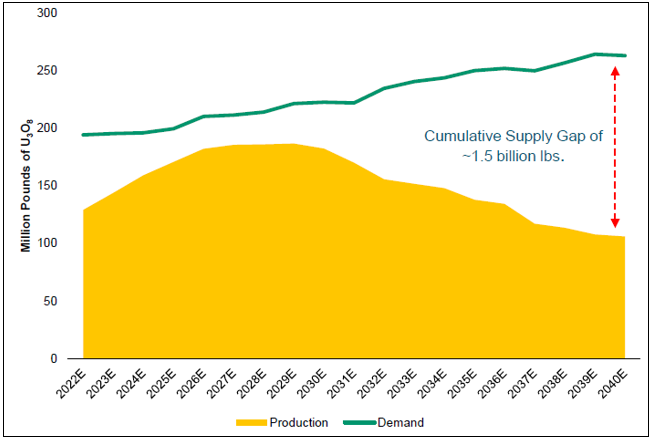
Sources: UxC LLC. Data as of Q2 2023. World Nuclear Association as of 8/1/2023. Included for illustrative purposes only. Past performance is no guarantee of future results.
Investment in Nuclear Energy Supportive of Uranium Bull Market
Because much of the recent growth in the nuclear industry has occurred overseas, U.S. investors often overlook the investment opportunity in the sector. The U.S. is also getting on the nuclear train, as the first newly constructed nuclear unit in the U.S. in over 30 years, Georgia Power’s Vogtle Unit 3, became commercially operational on July 31, 2023. Another unit serving the state of Georgia is expected to be completed in early 2024.12
While developed nations have nearly 70% of the global nuclear capacity, Asia is leading the growth in new construction. The announced energy plans for the UK, France, China, Poland and India include substantial reliance on nuclear power, while the U.S. is increasing investment in advanced reactor designs.13
To increase energy security, the U.S. continues passing legislation to reshape the nuclear fuel supply chain. The bipartisan Nuclear Fuel Security Act (NFSA) overwhelmingly cleared the U.S. Senate. It directed the U.S. Department of Energy to increase domestic nuclear fuel production to ensure supply will not affect current and future nuclear reactors.14 The NFSA follows the ADVANCE Act, intended to cut Russia from the nuclear fuel supply chain.
Opportunity for Uranium Miners
This growing reliance on nuclear energy is increasing demand for uranium, and we believe this provides attractive investment opportunities for uranium miners. After decades of overproducing, uranium miners can no longer meet the demand from existing nuclear reactors,15 and the uranium production/demand imbalance may widen well into the next decade.16
Concern about future uranium supplies has utilities purchasing uranium in quantities not seen for a decade. Cameco, the world’s largest publicly traded uranium miner, has contracted to sell 118 million pounds of uranium this year, which compares to 125 million pounds for all of 2022. Uranium spot prices have increased more than 19% YTD17 and are beginning to present an incentive for certain miners to expand their uranium production. In the emerging uranium bull market, spot prices are starting to approach incentive ranges that make developing greenfield projects (new exploration on unmined terrain) economically viable. Uranium miners may be poised to generate higher revenues and potential profits when mining production ramps up. As shown in Figure 7, uranium mining stocks have historically performed better than the underlying uranium spot price in advancing markets.
Figure 7. Uranium Equities Have Outperformed During Uranium Bull Markets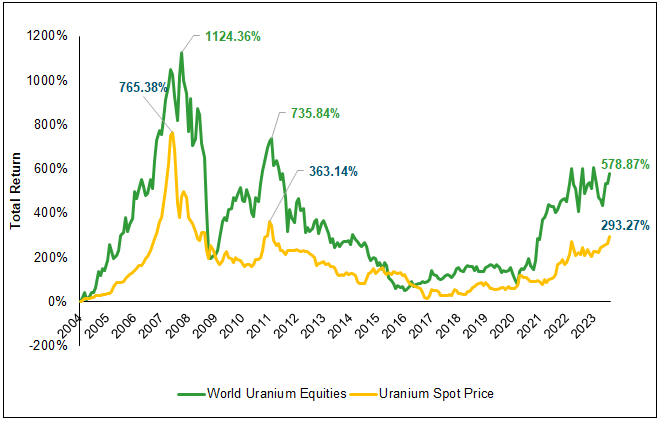
Sources: Bloomberg and TradeTech LLC. Data from 1/30/2004 to 06/30/2023 reflect the longest available data. World Uranium Equities are measured by the URAX Index, which tracks the performance of stocks globally that conduct business with uranium. URAX and Uranium Spot are denominated in U.S. dollars. You cannot invest directly in an index. Included for illustrative purposes only. Past performance is no guarantee of future results.
How Does Uranium Fit in Portfolios?
We view physical uranium and uranium mining equities as potential opportunities for energy exposure in portfolios. If you take the S&P 500 Index,15 for example, energy represented an Index weighting of 4.10% as of June 30, 2023 (see Figure 8). Furthermore, energy represents more than 10% of the S&P 500's estimated net income, up from 6.5% in 2022. A balanced investment portfolio is likely to include an energy allocation, and uranium-related investments may make sense for a portion of this allocation, depending on an investor’s goals and risk tolerance.
Figure 8. Energy Represents 4.10% of the S&P 500 Index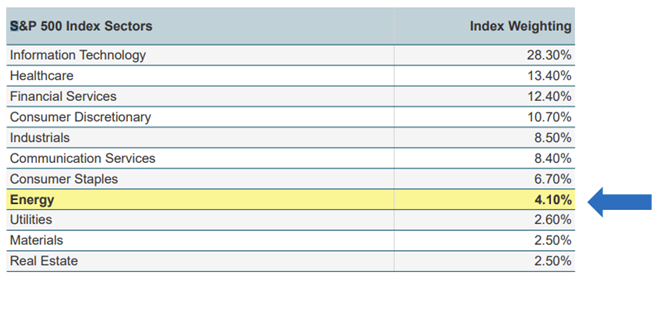
Source: S&P Dow Jones Indices, June 30, 2023. Included for illustrative purposes only. Past performance is no guarantee of future results.
Footnotes
| 1 | The U3O8 uranium spot price is measured by a proprietary composite of U3O8 spot prices from UxC, S&P Platts and Numerco. |
| 2 | The North Shore Global Uranium Mining Index (URNMX) was created by North Shore Indices, Inc. (the “Index Provider”). The Index Provider developed the methodology for determining the securities to be included in the Index and is responsible for the ongoing maintenance of the Index. The Index is calculated by Indxx, LLC, which is not affiliated with the North Shore Global Uranium Miners Fund (“Existing Fund”), ALPS Advisors, Inc. (the “Sub-Adviser”) or Sprott Asset Management LP (the “Adviser”). |
| 3 | The Standard & Poor's 500 Total Return Index is a market-capitalization-weighted index of the 500 largest U.S. publicly traded companies, and reflects dividends reinvested. |
| 4 | Source: World Nuclear Association as of 8/1/2023. |
| 5 | Source: IEA World Energy Outlook 2022 Stated Policies. |
| 6 | Source: IEA Electricity Market Report 2023. |
| 7 | Capacity factor measures the total amount of energy produced during a period divided by the amount of energy the plant would have produced at total capacity. Sources: U.S. Energy Information Administration and energy.gov. Data as of 12/31/2022.) |
| 8 | Source: Office of Nuclear Energy, 3 Reasons Why Nuclear is Clean and Sustainable. |
| 9 | Source: Pew Research Center, Growing share of Americans favor more nuclear power. |
| 10 | Source: World Nuclear News; Bloomberg; Sprott Asset Management LP; WMC Energy. |
| 11 | Source: Bloomberg, “Niger Coup Puts Trans‐Saharan Gas Pipeline at Risk,” 8/8/2023. |
| 12 | Source: Georgia Power, Press Release, “Vogtle Unit 3 Goes into Operation,” 7/31/2023. |
| 13 | Source: IEA Nuclear Power and Secure Energy Transitions. |
| 14 | Source: Senate Committee on Energy and Natural Resources, “Barrasso’s Nuclear Fuel Amendment Overwhelmingly Passes Senate,” 7/27/2023. |
| 15 | Source: OECD‐NEA/IAEA, World Nuclear Association as of 12/31/2022. |
| 16 | Source: UxC LLC. Data as of Q2 2021. |
| 17 | Source: Bloomberg as of 8/16/2023. |
Investment Risks and Important Disclosure
Relative to other sectors, precious metals and natural resources investments have higher headline risk and are more sensitive to changes in economic data, political or regulatory events, and underlying commodity price fluctuations. Risks related to extraction, storage and liquidity should also be considered.
Gold and precious metals are referred to with terms of art like "store of value," "safe haven" and "safe asset." These terms should not be construed to guarantee any form of investment safety. While “safe” assets like gold, Treasuries, money market funds and cash generally do not carry a high risk of loss relative to other asset classes, any asset may lose value, which may involve the complete loss of invested principal.
Past performance is no guarantee of future results. You cannot invest directly in an index. Investments, commentary and opinions are unique and may not be reflective of any other Sprott entity or affiliate. Forward-looking language should not be construed as predictive. While third-party sources are believed to be reliable, Sprott makes no guarantee as to their accuracy or timeliness. This information does not constitute an offer or solicitation and may not be relied upon or considered to be the rendering of tax, legal, accounting or professional advice.


